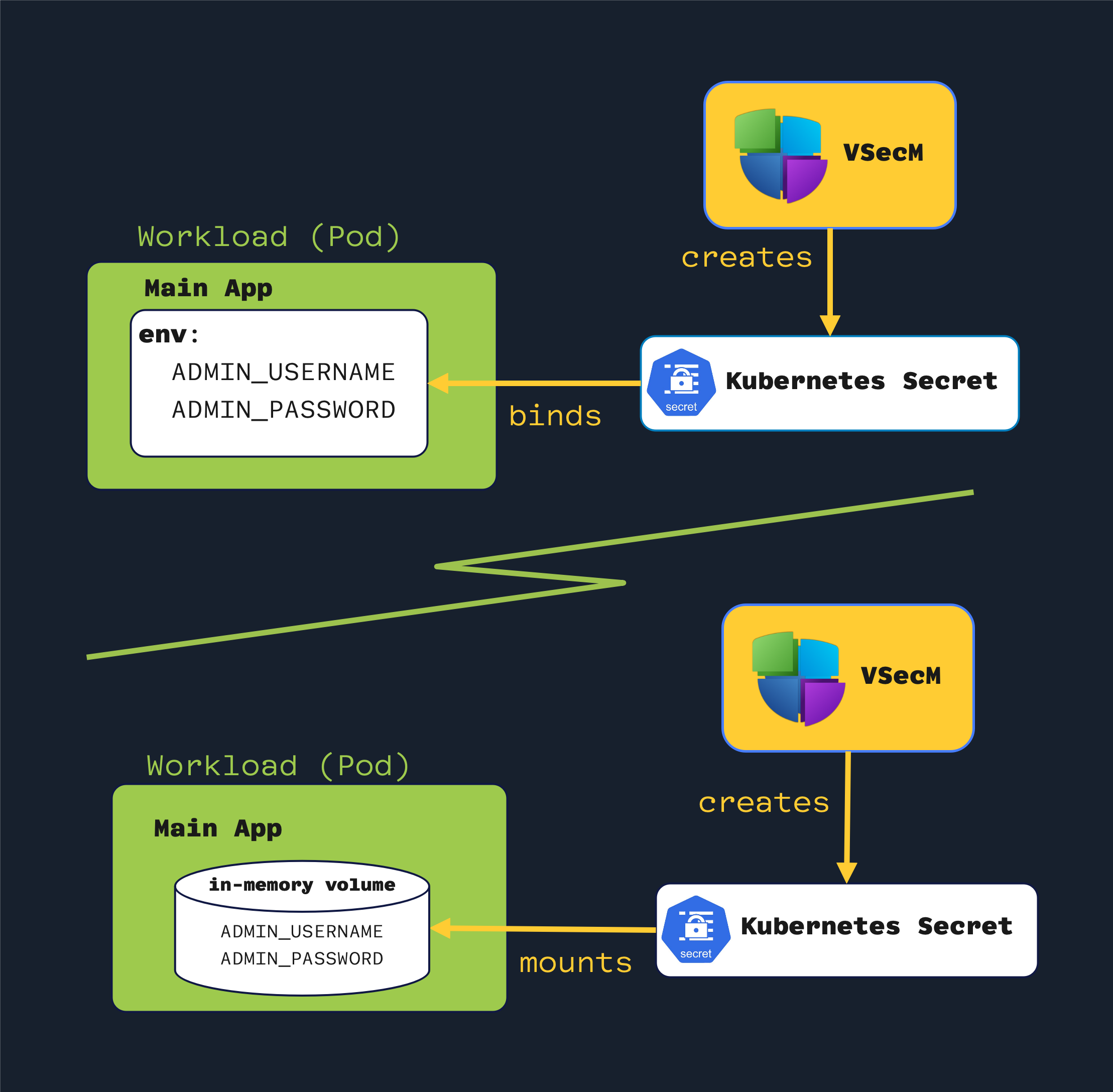VMware Secrets Manager
Mounting Kubernetes Secrets
Mark Your Calendars
The next
VSecM Contributor Sync
will be on…
Thursday, 2024-05-30
at 8:00am Pacific time.
Situation Analysis
This use case will mount VSecM-minted secrets as environment variables or files through Kubernetes Secrets. This approach is useful when deploying workloads using Helm charts that only allow creating secrets as Kubernetes secrets.
When you deploy a workload using a Helm chart and the Helm chart only allows you to create secrets as Kubernetes secrets, approaches like Fetching Secrets Using VSecM Sidecar, Fetching Secrets Using VSecM SDK, or even Mutating an In-Memory Template File could be unfeasible.
Luckily, VMware Secrets Manager can create and manage native Kubernetes Secrets in any namespace.
High-Level Diagram
Open the image in a new tab to see the full-size version:

Implementation
Using a VSecM-generated Kubernetes Secret is no different than how you would
use a regular Kubernetes Secret. This section will show you how to do it.
Environment Variables or Files
You can use the generated Kubernetes
Secretin the usual ways a KubernetesSecretis used. For example, you can bind environment variables from theSecretto your container or create a volume from the generated KubernetesSecret. VSecM will create a native KubernetesSecretfor you; how you use it will be up to you.
You can bind environment variables from the secret to your container or create a volume from the generated Kubernetes Secret.
Waiting for the Secret to be Ready
Once the workload is initialized, the secret must be ready for the workload to consume it. There are several strategies that you can follow for this.
- Using a custom Kubernetes Operator, you can configure your orchestrator to deploy the workload only after the secret is created.
- You can use a toolkit like Carvel to create a dependency relationship to guarantee the Secrets are created before the workloads.
- You can use the VSecM Init Container similarly to how
it’s described in the Mounting Secrets as Volumes use
case. For example, in an
initCommand:stanza, you can first create a KubernetesSecret, wait for the cluster to reconcile, then register a dummy secret to the workload to trigger a VSecM Init Container that the workload has to receive and initialize the main container (see the sample in the following section).
Don’t Want the Extra Wait?
VSecM Init Container could also wait for the existence of a Kubernetes
Secret–if you help us implement the feature. This way, you won’t have to add await:command that may fail depending on how busy the cluster is.Once this feature is implemented, the VSecM Init Container will only initialize the workload after ensuring the Kubernetes Secret is there and populated.
If you need this feature, your contributions are welcome:
In this walkthrough we will assume that the VSecM-generated Kubernetes Secret
will be created before the workload begins its lifecycle.
Creating a Kubernetes Secret
VSecM Helm Charts can be configured to provide secure
pattern-based random secrets for workloads. For example, we can modify the
initCommand stanza of sentinel Helm chart’s values.yaml to register a
random username and password as secrets for our example workload.
To create a Kubernetes Secret, prefix the name of the workload with k8s:
similar to the following example:
initCommand:
enabled: true
command: |
--
w:k8s:example-secret
n:example-apps
s:gen:{"username":"admin-[a-z0-9]{6}","password":"[a-zA-Z0-9]{12}"}
t:{"ADMIN_USER":"{{.username}}","ADMIN_PASS":"{{.password}}"}
--
wait:5000
--
w:example
n:example-apps
s:init
--
Note the k8s: prefix in the workload name. This prefix tells the VSecM
o create a Kubernetes Secret instead of a VSecM “secret”.
The above stanza is equivalent to this VSecM Sentinel command:
kubectl exec $SENTINEL -n vsecm-system -- safe \
-w "k8s:example-secret" \
-s 'gen:{"username":"admin-[a-z0-9]{6}","password":"[a-zA-Z0-9]{12}"}' \
-t '{"ADMIN_USER":"{{.username}}","ADMIN_PASS":"{{.password}}"}'
sleep(5)
kubectl exec $SENTINEL -n vsecm-system -- safe \
-w "example" \
-s 'init'
Don’t Forget to Create a ClusterSPIFFEID
For the VSecM Init Container to talk to VSecM Safe, your example workload will
need a ClusterSPIFFEID similar to the following:
apiVersion: spire.spiffe.io/v1alpha1
kind: ClusterSPIFFEID
metadata:
name: example
spec:
spiffeIDTemplate: "spiffe://vsecm.com\
/workload/example\
/ns/{{ .PodMeta.Namespace }}\
/sa/{{ .PodSpec.ServiceAccountName }}\
/n/{{ .PodMeta.Name }}"
podSelector:
matchLabels:
app: example-app
workloadSelectorTemplates:
- "k8s:ns:example-apps"
- "k8s:sa:example-sa"
You can check out Mounting Secrets as Volumes for a
separate example of how this ClusterSPIFFEID is created and evaluated.
That’s It
If you followed these steps, your workload would happily and securely consume VSecM-minted secure random secrets.
Conclusion
In conclusion, integrating VMware Secrets Manager with Kubernetes Secrets
offers a robust and flexible solution for managing and consuming secrets within
your Kubernetes workloads.
By leveraging VSecM to generate and manage Kubernetes Secrets, you can ensure
that your applications are provisioned with the necessary credentials, configurations,
and other sensitive data in a secure, automated fashion. The approach outlined
provides a clear path for securely injecting secrets into workloads, whether
through environment variables or files.
Additionally, implementing strategies such as waiting for secrets to be ready
before workload deployment, using VSecM Init Containers, and configuring
ClusterSPIFFEIDs further enhances the security and reliability of the secret
management process.
Contributions to further enhancing these capabilities, such as implementing new features in VSecM Init Containers, are encouraged and welcome.
results matching ""
No results matching ""